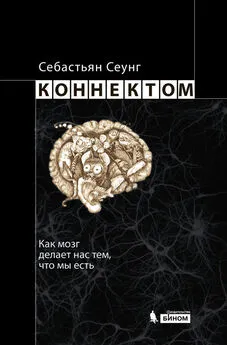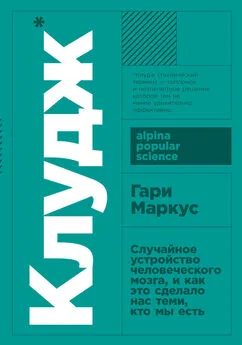Алан Джасанов - Мозг: прошлое и будущее [Что делает нас теми, кто мы есть]
- Название:Мозг: прошлое и будущее [Что делает нас теми, кто мы есть]
- Автор:
- Жанр:
- Издательство:Литагент АСТ
- Год:2019
- Город:Москва
- ISBN:978-5-17-117010-3
- Рейтинг:
- Избранное:Добавить в избранное
-
Отзывы:
-
Ваша оценка:
Алан Джасанов - Мозг: прошлое и будущее [Что делает нас теми, кто мы есть] краткое содержание
Мозг: прошлое и будущее [Что делает нас теми, кто мы есть] - читать онлайн бесплатно ознакомительный отрывок
Интервал:
Закладка:
462
Kevin Dunbar, «How Scientists Think: On-line Creativity and Conceptual Change in Science», в кн.: «Creative Thought: An Investigation of Conceptual Structures and Processes» , ed. Thomas B. Ward, Steven M. Smith, and Jyotsna Vaid (Washington, DC: American Psychological Association, 1997).
463
Конникова М. Выдающийся ум. Мыслить как Шерлок Холмс. (М.: Азбука Бизнес, 2014).
464
Jan Verplaetse, «Localising the Moral Sense: Neuroscience and the Search for the Cerebral Seat of Morality, 1800–1930» (New York: Springer, 2009).
465
L. Pascual, P. Rodrigues, and D. Gallardo-Pujol, «How does morality work in the brain? A functional and structural perspective of moral behavior», «Frontiers in Integrative Neuroscience» 7 (2013): 65.
466
S. Milgram, «Behavioral study of obedience», «Journal of Abnormal and Social Psychology» 67 (1963): 371–378.
467
Lauren Cassani Davis, «Do Emotions and Morality mix?» «Atlantic» , 5 февраля 2016 года.
468
Карлейль Т. Герои, почитание героев и героическое в истории / Пер. В. Яковенко. (СПб.: 1908).
469
William James, «Great Men, Great Thoughts, and the Environment», «Atlantic Monthly» (октябрь 1880 года).
470
K. Weir, «The roots of mental illness», «Monitor on Psychology» 43 (2012): 30.
471
G. Schomerus et al., «Evolution of public attitudes about mental illness: A systematic review and meta-analysis», «Acta Psychiatrica Scandinavica» 125 (2012): 440–452.
472
Фуко М. История безумия в классическую эпоху / пер. И. Стаф. (СПб.: Университетская книга, 1997).
473
Samuel Tuke, «Description of the Retreat, an Institution near York, for Insane Persons of the Society of Friends: Containing an Account of Its Origins and Progress, the Modes of Treatment, and a Statement of Cases» (York, UK: Isaac Peirce, 1813).
474
Фуко М. История безумия в классическую эпоху.
475
«Mental Health Facts in America», National Alliance on Mental Illness, 2015, nami.org/Learn-More/Mental-Health-By-the-Numbers.
476
Doug Stanglin, «Aurora Suspect James Holmes Sent His Doctor Burned Money», «USA Today» , 10 декабря 2012 года.
477
James Holmes, Laboratory Notebook, University of Colorado, 2012.
478
Ann O’Neill, Ana Cabrera, and Sara Weisfeldt, «A Look Inside the „Broken“ Mind of James Holmes», CNN, 10 июня 2017 года.
479
Ann O’Neill and Sara Weisfeldt, «Psychiatrist: Holmes Thought 3–4 Times a Day About Killing», CNN, 10 июня 2017 года.
480
Jack Bragen, «Schizophrenia: My 35-Year Battle» (Raleigh, NC: Lulu, 2015).
481
Jack Bragen, «On Mental Illness: The Sacrifices of Being Medicated», «Berkeley Daily Planet» , 11 мая 2011 года.
482
P. W. Corrigan, J. E. Larson, and N. Rusch, «Self-stigma and the „why try“ effect: Impact on life goals and evidence-based practices», «World Psychiatry» 8 (2009): 75–81.
483
Schomerus et al., «Evolution of public attitudes about mental illness: A systematic review and meta-analysis.»
484
P. W. Corrigan and A. C. Watson, «At issue: Stop the stigma: Call mental illness a brain disease», «Schizophrenia Bulletin» 30 (2004): 477–479.
485
P. R. Reilly, «Eugenics and involuntary sterilization: 1907–2015», «Annual Review of Genomics and Human Genetics» 16 (2015): 351–368.
486
Dana Goldstein, «Sterilization’s Cruel Inheritance», «New Republic» , 4 марта 2016 года.
487
Carrie Buck v. John Hendren Bell, 274 U.S. 200 (1927).
488
J. Pfeiffer, «Neuropathology in the Third Reich», Brain Pathology 1 (1991): 125–131.
489
Henry Friedlander, «The Origins of Nazi Genocide: From Euthanasia to the Final Solution» (Chapel Hill: University of North Carolina Press, 1997).
490
J. T. Hughes, «Neuropathology in Germany during World War II: Julius Hallervorden (1882–1965) and the Nazi programme of „euthanasia,“» «Journal of Medical Biography» 15 (2007): 116–122.
491
J. Pfeiffer, «Phases in the postwar German Reception of the „euthanasia program“ (1939–1945) involving the killing of the mentally disabled and its exploitation by neuroscientists», «Journal of the History of the Neurosciences» 15 (2006): 210–244.
492
R. Ahren, «German Institute Finds Brain Parts Used by Nazis for Research During, and After, WWII», «Times of Israel» , 31 августа 2016 года.
493
Roy Porter, «Madness and Its Institutions», в кн.: «Medicine in Society: Historical Essays» , ed. Andrew Wear (Cambridge, UK: Cambridge University Press, 1992).
494
Mark Davis, «Asylum: Inside the Pauper Lunatic Asylums» (Stroud, UK: Amberley, 2014).
495
H. R. Rollin, «Psychiatry in Britain one hundred years ago», «British Journal of Psychiatry» 183 (2003): 292–298.
496
Chris Pleasance, «Faces from the Asylum: Harrowing Portraits of Patients at Victorian „Lunatic“ Hospital Where They Were Treated for „Mania, Melancholia and General Paralysis of the Insane,“» «Daily Mail» , 18 марта 2015 года.
497
Ezra Susser, Sharon Schwartz, Alfredo Morabia, and Evelyn J. Bromet, eds., «Psychiatric Epidemiology: Searching for the Causes of Mental Disorders» (New York: Oxford University Press, 2006).
498
W. S. Bainbridge, «Religious insanity in America: The official nineteenth-century theory», «Sociological Analysis» 45 (1984).
499
G. Davis, «The most deadly disease of asylumdom: General paralysis of the insane and Scottish psychiatry, c. 1840–1940», «Journal of the Royal College of Physicians of Edinburgh» 42 (2012): 266–273.
500
J. M. S. Pearce, «Brain disease leading to mental illness: A concept initiated by the discovery of general paralysis of the insane», «European Neurology» 67 (2012): 272–278.
501
J. Hurn, «The changing fortunes of the general paralytic», «Wellcome History» 4 (1997): 5.
502
«Pellagra and Its Prevention and Control in Major Emergencies» , World Health Organization, 2000.
503
Charles S. Bryan, «Asylum Doctor: James Woods Babcock and the Red Plague of Pellagra» (Columbia: University of South Carolina Press, 2014).
504
V. P. Sydenstricker, «The history of pellagra, its recognition as a disorder of nutrition and its conquest», «American Journal of Clinical Nutrition» 6 (1958): 409–414.
505
Флек Людвиг. Возникновение и развитие научного факта: Введение в теорию стиля мышления и мыслительного коллектива. (М.: Идея-Пресс, Дом интеллектуальной книги, 1999).
506
Stephen V. Faraone, Stephen J. Glatt, and Ming T. Tsuang, «Genetic Epidemiology», в кн. «Textbook of Psychiatric Epidemiology» , ed. Ming T. Tsuang, Mauricio Tohen, and Peter B. Jones (Hoboken, NJ: John Wiley & Sons, 2011).
507
R. Plomin, M. J. Owen, and P. McGuffin, «The genetic basis of complex human behaviors», «Science» 264 (1994): 1733–1739.
508
Judith Allardyce, Jim van Os, «Examining Gene-Environment Interplay in Psychiatric Disorders», в кн.: Tsuang, Tohen, and Jones, eds., «Textbook of Psychiatric Epidemiology» .
509
M. Burmeister, M. G. McInnis, and S. Zollner, «Psychiatric genetics: Progress amid controversy», «Nature Reviews Genetics» 9 (2008): 527–540.
510
P. F. Sullivan, M. J. Daly, and M. O’Donovan, «Genetic architectures of psychiatric disorders: The emerging picture and its implications», «Nature Reviews Genetics» 13 (2012): 537–551.
511
Такую точку зрения поддерживает крупное исследование, проведенное в 2014 году (F. A. Wright et al., «Heritability and genomics of gene expression in peripheral blood», «Nature» Genetics» 46 [2014]: 430–437): ученые обнаружили, что около 70 % генов, связываемых с наследственными расстройствами аутистического спектра или умственной отсталостью, ассоциируются с изменениями экспрессии генов, которые влияют на состав крови, то есть физиологическое воздействие на функционирование мозга, вероятно, оказывают внемозговые факторы. В 2013 году обзор исследований связи между ожирением и депрессией у молодежи и подростков (D. Nemiary et al., „The relationship between obesity and depression among adolescents“, „Psychiatric Annual“ 42 [2013]: 305–308), в частности, показал, что тучные подростки с большей вероятностью сталкиваются с трудностями в школе и психолого-психиатрическими расстройствами, что в значительной степени связано с травлей и недовольством своим телом. Поскольку ожирение, в свою очередь, отчасти вызывается генетическими причинами, связь депрессии и ожирения служит яркой иллюстрацией того, как гены опосредованно влияют на мозг и сознание.
512
M. Schwarzbold et al., «Psychiatric disorders and traumatic brain injury», «Neuropsychiatric Disease and Treatment» 4 (2008): 797–816.
Читать дальшеИнтервал:
Закладка:
![Обложка книги Алан Джасанов - Мозг: прошлое и будущее [Что делает нас теми, кто мы есть]](/books/1070785/alan-dzhasanov-mozg-proshloe-i-buduchee-chto-delaet.webp)







